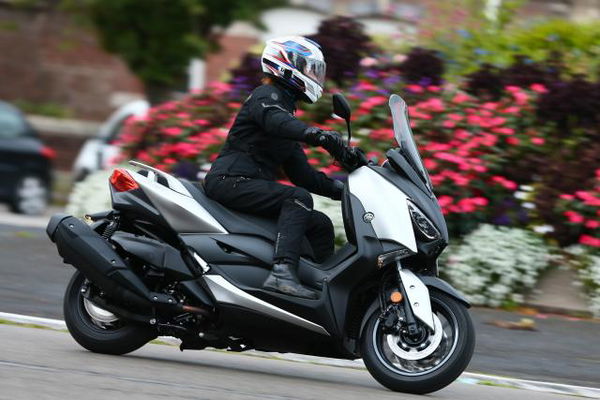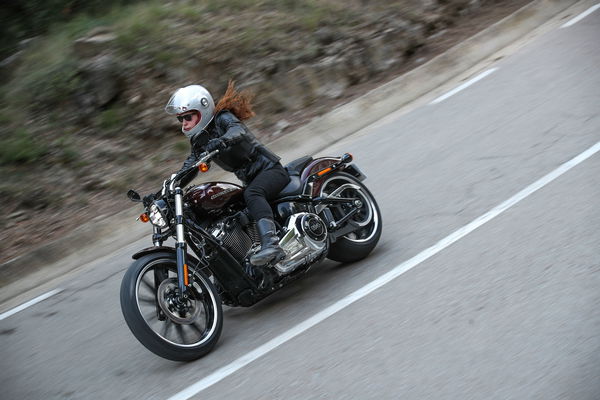First ride: Yamaha XMAX 400 review
We put the XMAX 400 through its paces with a road trip to France

YAMAHA is arguably a pioneer of the maxi scooter, having debuted its first model – the TMAX – back when dinosaurs roamed the earth… well, in 2001.
Over the past 16 years, the segment has grown exponentially, and maxi-scooters are now 10-a-penny in many European cities.
The Japanese manufacturer has remained on top of the game, thanks to premium quality, reliability, and seemingly being able to predict exactly where the scooter market is going.
So where does the XMAX 400 fit in? Introduced in 2013, the medium-capacity model really exists to bridge the gap between the motorcycle-rivaling TMAX 530, and the lower capacity, inner city XMAX 300.
But it’s also a competent offering in its own right, especially in the 2018 guise that I've tested at launch this week.
It’s comfortable, capable at motorway speeds, agile around town and features sporty styling – what’s not to like?
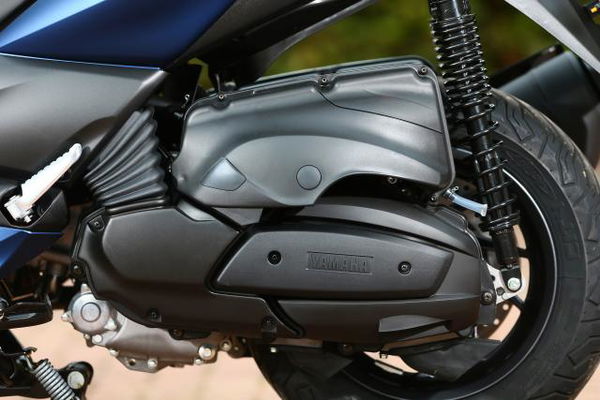
Engine:
While the larger capacity TMAX features a centrally mounted engine, the XMAX 400 implements a swingarm mounted unit, more commonly seen in smaller scooters.
There are both advantages and disadvantages to this arrangement. While it allows for more storage space under the seat – room for two full-face helmets, in fact – the weight over the back wheel could make for a lighter front end. Yamaha’s engineers countered this back in 2013 by moving the battery and fuel tank forward.
But back to this engine – at 395cc it sits square in the middle of scooter territory. Making 32.9hp, the Euro4 unit is surprisingly powerful, and torque is available from the off, reaching peak of 26.6lbft at 6,000 rpm. Acceleration is smooth and linear up until around 70mph, or 6,500 rpm, where it noticeably wanes, ahead of the claimed 7,000rpm power peak.
In 500-odd miles, I never once needed to reach the redline, and didn’t feel like I was ragging the throttle, despite pushing the scooter hard on both motorways and B-roads. The engine is easily good enough for the national limit and beyond, although the 15-inch front wheel begins to wobble slightly at around 70 mph.
Yamaha claims a fuel economy of 67.6mpg, which I bettered to 69.2mpg after a gentle country road ride. However, it dropped to 62mpg after a spirited motorway sprint.
The engine idles at 1,500 revs, and the scooter can crawl at under 10mph at around 2,000 revs, which is handy because putting feet down and paddling is an awkward affair due to wide seat.
Handling:
On the go, the XMAX 400 feels light and agile - more so than the previous model, thanks to a 5kg weight reduction. It’s easy to steer, even at low speeds, and has a tight turning circle.
However, it still weighs 210kg wet and while you don’t notice that mass on the move, it becomes obvious when you try to push the bike, or put your feet down to paddle along. The wide seat, which at 800mm is also quite tall hinders paddling, and I found that I could not get both feet on the ground, unless I moved to in front of the seat.
It leans into corners well, but too much of an angle and the centre stand will scrape along the floor, which is quite disconcerting.
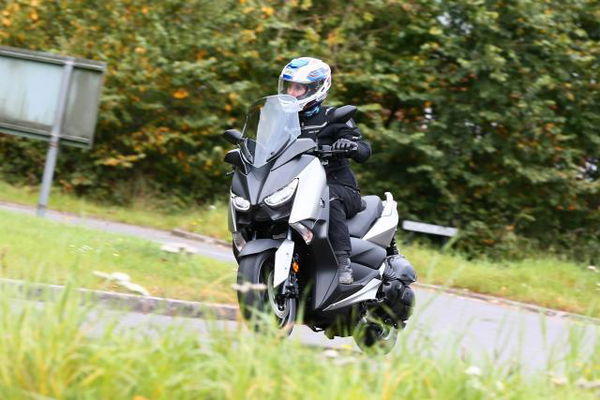
A host of adjustable elements, including handlebars, screen and rear suspension allow the rider to customise the XMAX 400 to your size and riding style, and once you find your perfect set up, it offers an agreeable ride. While the seat itself is well-padded and comfortable, the lumbar supporting back rest could do with some forward adjustment, as shorter riders will likely end up sitting further forward on the seat.
Personally, I preferred the screen on its higher setting as it significantly reduced wind buffeting and noise on the motorway. Equally, with the bars in the further away position my arms became less fatigued, and the upright riding position came more naturally.
Unfortunately, to make these adjustments requires tools, and it’s not a quick job. I would have liked to be able to lower the screen immediately each time we entered a town, to improve visibility.
Suspension:
New for 2018 are the XMAX’s motorcycle-type dual clamp front forks and long travel (107mm) rear suspension with preload adjustment.
I rode the XMAX with the suspension on its middle setting – as with the screen and bars it requires tools to adjust – and found it to be quite firm. Meanwhile, the front forks swallow small bumps to give the scooter a steady, stable ride.
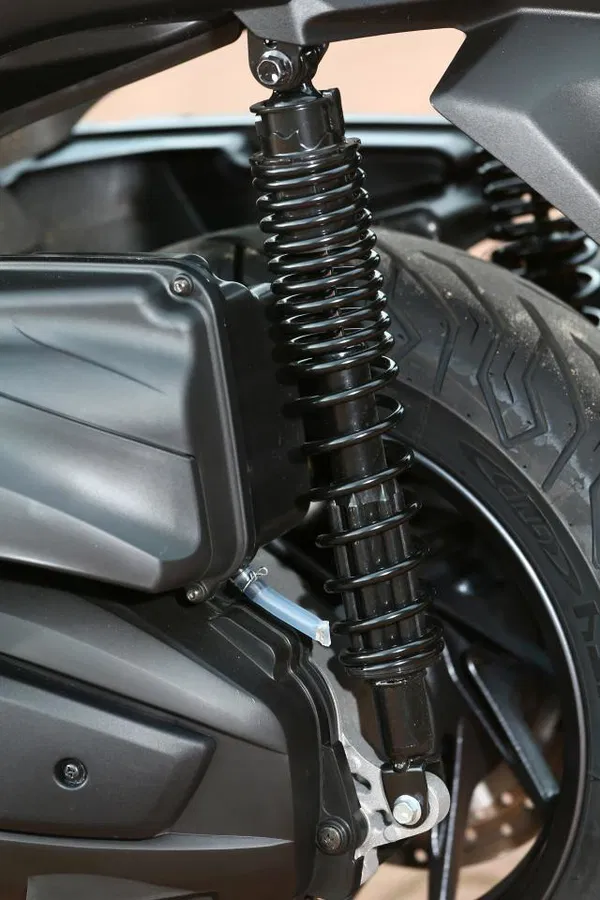
Brakes:
The XMAX 400 features dual disc brakes up front, and a single disc at the rear.
Surprisingly, I preferred the feel of the rear brake over the front. Despite those twin discs up front, the rear felt sharper and more progressive, ultimately bringing the bike to a quicker, more stable stop.
ABS is standard, and unobtrusive, only kicking in when needed, while basic traction control inspires confidence on slippery road surfaces – although thanks to the OE Michelin City Grip tyres it was rarely needed.
There’s also a parking brake, activated by a simple lever, which secures the scooter while at a standstill.
Equipment:
Where this scooter excels is in its equipment and attention to detail.
I tested the £5,999 bike in its standard form, with the addition of heated grips. At £134 they’re a must have accessory, as while the cleverly designed front faring shielded most of the wind from my hands, I could feel my fingers getting chilly after too long.
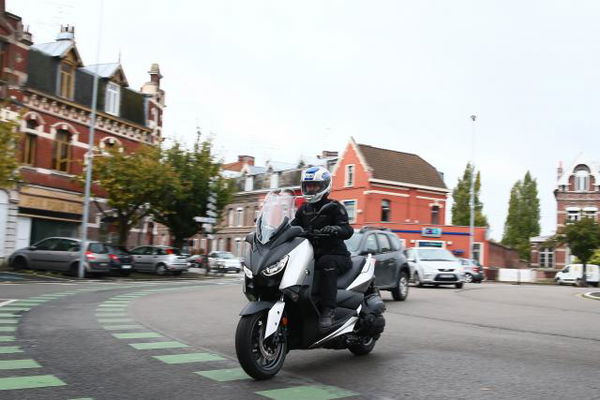
That front faring features Yamaha’s recognisable twin LED headlight scooter face, while from the side the Japanese manufacturer’s 'boomerang' bodywork is clearly visible. In all, it’s as stylish and sporty as a commuter scooter could be.
Under the seat there’s a huge storage space, which claims to fit two full-face helmets, however my Shoei GT Air would only fit in the rear part of the compartment – prospective buyers should check that their helmets will fit. Double stitched seams and a handy underseat light are proof of Yamaha’s attention to detail. The button to open the left of XMAX’s two gloveboxes is not, however. Labelled ‘Lid’ it took me a while to work out exactly what it operated. Inside, there is a handy 12V power socket.
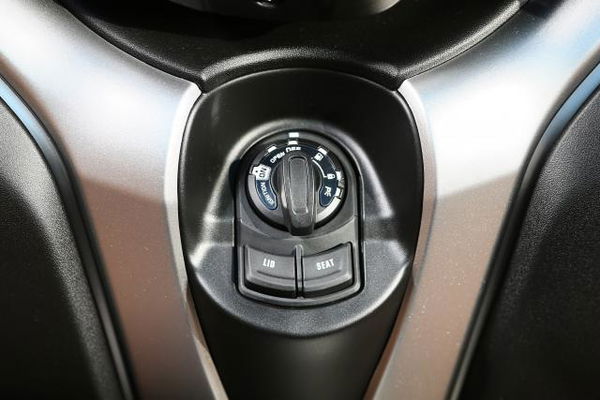
In front of the rider is a smart instrument panel, which features a pair of classic analogue dials against a black background, with a multi-function LCD display in the middle. It’s easy to change what it displays, via a thumb switch on the right handlebar.
Yamaha’s ‘Smart key’ keyless ignition allows you to operate the scooter without a key, providing the fob is on your person. You push a knob in and then twist it to the require function – eg. on, fuel, steering lock, open. If you forget to return the switch to ‘off’ before walking away – which happens surprisingly often – the ignition beeps repeatedly.
We like:
The XMAX 400 is well equipped, with a premium finish and keyless ignition, and at £5,999 is an attractive option for riders not yet ready to commit to the £10,899 TMAX 530
We don't like:
The beeping ignition is an extremely useful tool, but it can be a little overzealous in reminding you not to leave the scooter switched on. A number of times I stopped the scooter, turned the engine off and remained on the vehicle, only for the ignition to begin beeping incessantly.
CLICK NEXT FOR VERDICT AND SPECS.
Verdict:
Arguably, I’m not Yamaha’s target audience for the XMAX 400, and while I found it to be impressively capable, I also found it unengaging and boring.
But as the old adage goes: different strokes for different folks, and there’s plenty of folks who won’t find many better options in the sporty maxi-scooter market than the XMAX 400.
Specs:
Model tested: Yamaha XMAX 400
Price: £5,999
Engine: 395cc swingarm-mounted
Power: 32.9hp @ 7,000rpm
Torque: 36.0 Nm @ 6,000 rpm
Kerb weight: 210kg
Seat height: 800mm
